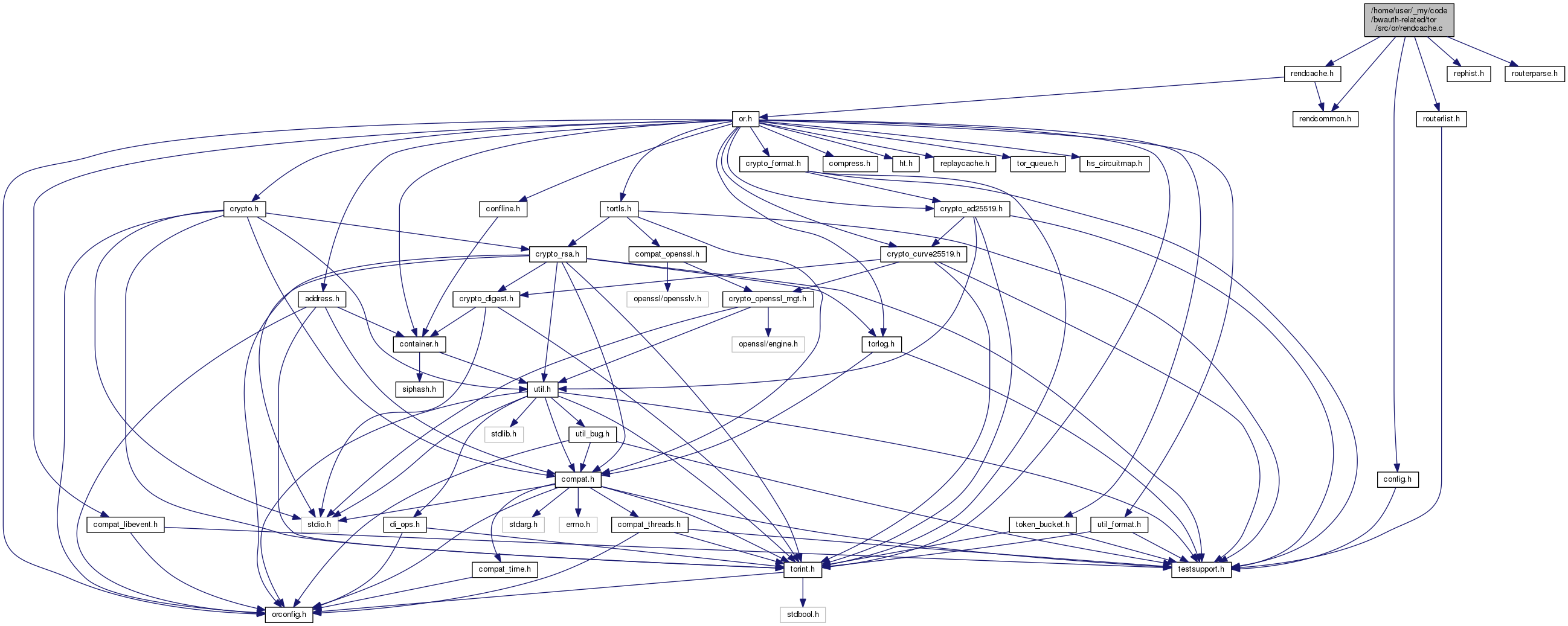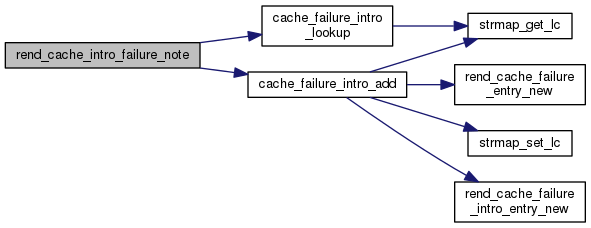Hidden service descriptor cache. More...
#include "rendcache.h"#include "config.h"#include "rephist.h"#include "routerlist.h"#include "routerparse.h"#include "rendcommon.h"
Functions | |
| void | rend_cache_init (void) |
| STATIC size_t | rend_cache_entry_allocation (const rend_cache_entry_t *e) |
| size_t | rend_cache_get_total_allocation (void) |
| void | rend_cache_decrement_allocation (size_t n) |
| void | rend_cache_increment_allocation (size_t n) |
| STATIC void | rend_cache_failure_intro_entry_free_ (rend_cache_failure_intro_t *entry) |
| STATIC rend_cache_failure_intro_t * | rend_cache_failure_intro_entry_new (rend_intro_point_failure_t failure) |
| STATIC void | rend_cache_failure_entry_free_ (rend_cache_failure_t *entry) |
| STATIC void | rend_cache_failure_entry_free_void (void *entry) |
| STATIC rend_cache_failure_t * | rend_cache_failure_entry_new (void) |
| STATIC void | rend_cache_failure_remove (rend_service_descriptor_t *desc) |
| STATIC void | rend_cache_entry_free_ (rend_cache_entry_t *e) |
| void | rend_cache_free_all (void) |
| void | rend_cache_failure_clean (time_t now) |
| void | rend_cache_clean (time_t now, rend_cache_type_t cache_type) |
| void | rend_cache_purge (void) |
| void | rend_cache_failure_purge (void) |
| STATIC int | cache_failure_intro_lookup (const uint8_t *identity, const char *service_id, rend_cache_failure_intro_t **intro_entry) |
| STATIC void | cache_failure_intro_add (const uint8_t *identity, const char *service_id, rend_intro_point_failure_t failure) |
| STATIC void | validate_intro_point_failure (const rend_service_descriptor_t *desc, const char *service_id) |
| void | rend_cache_intro_failure_note (rend_intro_point_failure_t failure, const uint8_t *identity, const char *service_id) |
| size_t | rend_cache_clean_v2_descs_as_dir (time_t cutoff) |
| int | rend_cache_lookup_entry (const char *query, int version, rend_cache_entry_t **e) |
| int | rend_cache_lookup_v2_desc_as_service (const char *query, rend_cache_entry_t **e) |
| int | rend_cache_lookup_v2_desc_as_dir (const char *desc_id, const char **desc) |
| int | rend_cache_store_v2_desc_as_dir (const char *desc) |
| int | rend_cache_store_v2_desc_as_service (const char *desc) |
| int | rend_cache_store_v2_desc_as_client (const char *desc, const char *desc_id_base32, const rend_data_t *rend_query, rend_cache_entry_t **entry) |
Variables | |
| STATIC strmap_t * | rend_cache = NULL |
| STATIC digestmap_t * | rend_cache_v2_dir = NULL |
| STATIC strmap_t * | rend_cache_failure = NULL |
| STATIC size_t | rend_cache_total_allocation = 0 |
Detailed Description
Hidden service descriptor cache.
Function Documentation
◆ cache_failure_intro_add()
| STATIC void cache_failure_intro_add | ( | const uint8_t * | identity, |
| const char * | service_id, | ||
| rend_intro_point_failure_t | failure | ||
| ) |
Add an intro point failure to the failure cache using the relay identity and service ID service_id. Record the failure in that object.


◆ cache_failure_intro_lookup()
| STATIC int cache_failure_intro_lookup | ( | const uint8_t * | identity, |
| const char * | service_id, | ||
| rend_cache_failure_intro_t ** | intro_entry | ||
| ) |
Lookup the rend failure cache using a relay identity digest in identity which has DIGEST_LEN bytes and service ID service_id which is a null-terminated string. If found, the intro failure is set in intro_entry else it stays untouched. Return 1 iff found else 0.


◆ rend_cache_clean()
| void rend_cache_clean | ( | time_t | now, |
| rend_cache_type_t | cache_type | ||
| ) |
Removes all old entries from the client or service descriptor cache.
◆ rend_cache_clean_v2_descs_as_dir()
| size_t rend_cache_clean_v2_descs_as_dir | ( | time_t | cutoff | ) |
Remove all old v2 descriptors and those for which this hidden service directory is not responsible for any more. The cutoff is the time limit for which we want to keep the cache entry. In other words, any entry created before will be removed.

◆ rend_cache_decrement_allocation()
| void rend_cache_decrement_allocation | ( | size_t | n | ) |
Decrement the total bytes attributed to the rendezvous cache by n.

◆ rend_cache_entry_allocation()
| STATIC size_t rend_cache_entry_allocation | ( | const rend_cache_entry_t * | e | ) |
Return the approximate number of bytes needed to hold e.

◆ rend_cache_entry_free_()
| STATIC void rend_cache_entry_free_ | ( | rend_cache_entry_t * | e | ) |
Helper: free storage held by a single service descriptor cache entry.

◆ rend_cache_failure_clean()
| void rend_cache_failure_clean | ( | time_t | now | ) |
Remove all entries that re REND_CACHE_FAILURE_MAX_AGE old. This is called every second.
We have to clean these regurlarly else if for whatever reasons an hidden service goes offline and a client tries to connect to it during that time, a failure entry is created and the client will be unable to connect for a while even though the service has return online.
◆ rend_cache_failure_entry_free_()
| STATIC void rend_cache_failure_entry_free_ | ( | rend_cache_failure_t * | entry | ) |
Helper: free a rend cache failure object.

◆ rend_cache_failure_entry_free_void()
| STATIC void rend_cache_failure_entry_free_void | ( | void * | entry | ) |
Helper: deallocate a rend_cache_failure_t. (Used with strmap_free(), which requires a function pointer whose argument is void*).

◆ rend_cache_failure_entry_new()
| STATIC rend_cache_failure_t* rend_cache_failure_entry_new | ( | void | ) |
Allocate a rend cache failure object and return it. This function can not fail.

◆ rend_cache_failure_intro_entry_free_()
| STATIC void rend_cache_failure_intro_entry_free_ | ( | rend_cache_failure_intro_t * | entry | ) |
Helper: free a rend cache failure intro object.
◆ rend_cache_failure_intro_entry_new()
| STATIC rend_cache_failure_intro_t* rend_cache_failure_intro_entry_new | ( | rend_intro_point_failure_t | failure | ) |
Allocate a rend cache failure intro object and return it. failure is set into the object. This function can not fail.

◆ rend_cache_failure_purge()
| void rend_cache_failure_purge | ( | void | ) |
Remove ALL entries from the failure cache. This is also called when a NEWNYM signal is received.

◆ rend_cache_failure_remove()
| STATIC void rend_cache_failure_remove | ( | rend_service_descriptor_t * | desc | ) |
Remove failure cache entry for the service ID in the given descriptor desc.


◆ rend_cache_free_all()
| void rend_cache_free_all | ( | void | ) |
Free all storage held by the service descriptor cache.
◆ rend_cache_increment_allocation()
| void rend_cache_increment_allocation | ( | size_t | n | ) |
Increase the total bytes attributed to the rendezvous cache by n.
◆ rend_cache_init()
| void rend_cache_init | ( | void | ) |
Initializes the service descriptor cache.
◆ rend_cache_intro_failure_note()
| void rend_cache_intro_failure_note | ( | rend_intro_point_failure_t | failure, |
| const uint8_t * | identity, | ||
| const char * | service_id | ||
| ) |
Note down an intro failure in the rend failure cache using the type of failure in failure for the relay identity digest in identity and service ID service_id. If an entry already exists in the cache, the failure type is changed with failure.

◆ rend_cache_lookup_entry()
| int rend_cache_lookup_entry | ( | const char * | query, |
| int | version, | ||
| rend_cache_entry_t ** | e | ||
| ) |
Lookup in the client cache the given service ID query for version.
Return 0 if found and if e is non NULL, set it with the entry found. Else, a negative value is returned and e is untouched. -EINVAL means that query is not a valid service id. -ENOENT means that no entry in the cache was found.

◆ rend_cache_lookup_v2_desc_as_dir()
| int rend_cache_lookup_v2_desc_as_dir | ( | const char * | desc_id, |
| const char ** | desc | ||
| ) |
Lookup the v2 service descriptor with base32-encoded desc_id and copy the pointer to it to *desc. Return 1 on success, 0 on well-formed-but-not-found, and -1 on failure.

◆ rend_cache_purge()
| void rend_cache_purge | ( | void | ) |
Remove ALL entries from the rendezvous service descriptor cache.

◆ rend_cache_store_v2_desc_as_client()
| int rend_cache_store_v2_desc_as_client | ( | const char * | desc, |
| const char * | desc_id_base32, | ||
| const rend_data_t * | rend_query, | ||
| rend_cache_entry_t ** | entry | ||
| ) |
Parse the v2 service descriptor in desc, decrypt the included list of introduction points with descriptor_cookie (which may also be NULL if decryption is not necessary), and store the descriptor to the local cache under its version and service id.
If we have a newer v2 descriptor with the same ID, ignore this one. If we have an older descriptor with the same ID, replace it. If the descriptor's service ID does not match rend_query->onion_address, reject it.
If the descriptor's descriptor ID doesn't match desc_id_base32, reject it.
Return 0 on success, or -1 if we rejected the descriptor. If entry is not NULL, set it with the cache entry pointer of the descriptor.
◆ rend_cache_store_v2_desc_as_dir()
| int rend_cache_store_v2_desc_as_dir | ( | const char * | desc | ) |
Parse the v2 service descriptor(s) in desc and store it/them to the local rend cache. Don't attempt to decrypt the included list of introduction points (as we don't have a descriptor cookie for it).
If we have a newer descriptor with the same ID, ignore this one. If we have an older descriptor with the same ID, replace it.
Return 0 on success, or -1 if we couldn't parse any of them.
We should only call this function for public (e.g. non bridge) relays.

◆ rend_cache_store_v2_desc_as_service()
| int rend_cache_store_v2_desc_as_service | ( | const char * | desc | ) |
Parse the v2 service descriptor in desc and store it to the local service rend cache. Don't attempt to decrypt the included list of introduction points.
If we have a newer descriptor with the same ID, ignore this one. If we have an older descriptor with the same ID, replace it.
Return 0 on success, or -1 if we couldn't understand the descriptor.
◆ validate_intro_point_failure()
| STATIC void validate_intro_point_failure | ( | const rend_service_descriptor_t * | desc, |
| const char * | service_id | ||
| ) |
Using a parsed descriptor desc, check if the introduction points are present in the failure cache and if so they are removed from the descriptor and kept into the failure cache. Then, each intro points that are NOT in the descriptor but in the failure cache for the given service_id are removed from the failure cache.
Variable Documentation
◆ rend_cache
| STATIC strmap_t* rend_cache = NULL |
Map from service id (as generated by rend_get_service_id) to rend_cache_entry_t.
◆ rend_cache_failure
| STATIC strmap_t* rend_cache_failure = NULL |
(Client side only) Map from service id to rend_cache_failure_t. This cache is used to track intro point(IP) failures so we know when to keep or discard a new descriptor we just fetched. Here is a description of the cache behavior.
Everytime tor discards an IP (ex: receives a NACK), we add an entry to this cache noting the identity digest of the IP and it's failure type for the service ID. The reason we indexed this cache by service ID is to differentiate errors that can occur only for a specific service like a NACK for instance. It applies for one but maybe not for the others.
Once a service descriptor is fetched and considered valid, each IP is looked up in this cache and if present, it is discarded from the fetched descriptor. At the end, all IP(s) in the cache, for a specific service ID, that were NOT present in the descriptor are removed from this cache. Which means that if at least one IP was not in this cache, thus usuable, it's considered a new descriptor so we keep it. Else, if all IPs were in this cache, we discard the descriptor as it's considered unusable.
Once a descriptor is removed from the rend cache or expires, the entry in this cache is also removed for the service ID.
This scheme allows us to not rely on the descriptor's timestamp (which is rounded down to the hour) to know if we have a newer descriptor. We only rely on the usability of intro points from an internal state.
◆ rend_cache_v2_dir
| STATIC digestmap_t* rend_cache_v2_dir = NULL |
Map from descriptor id to rend_cache_entry_t; only for hidden service directories.
 1.8.13
1.8.13